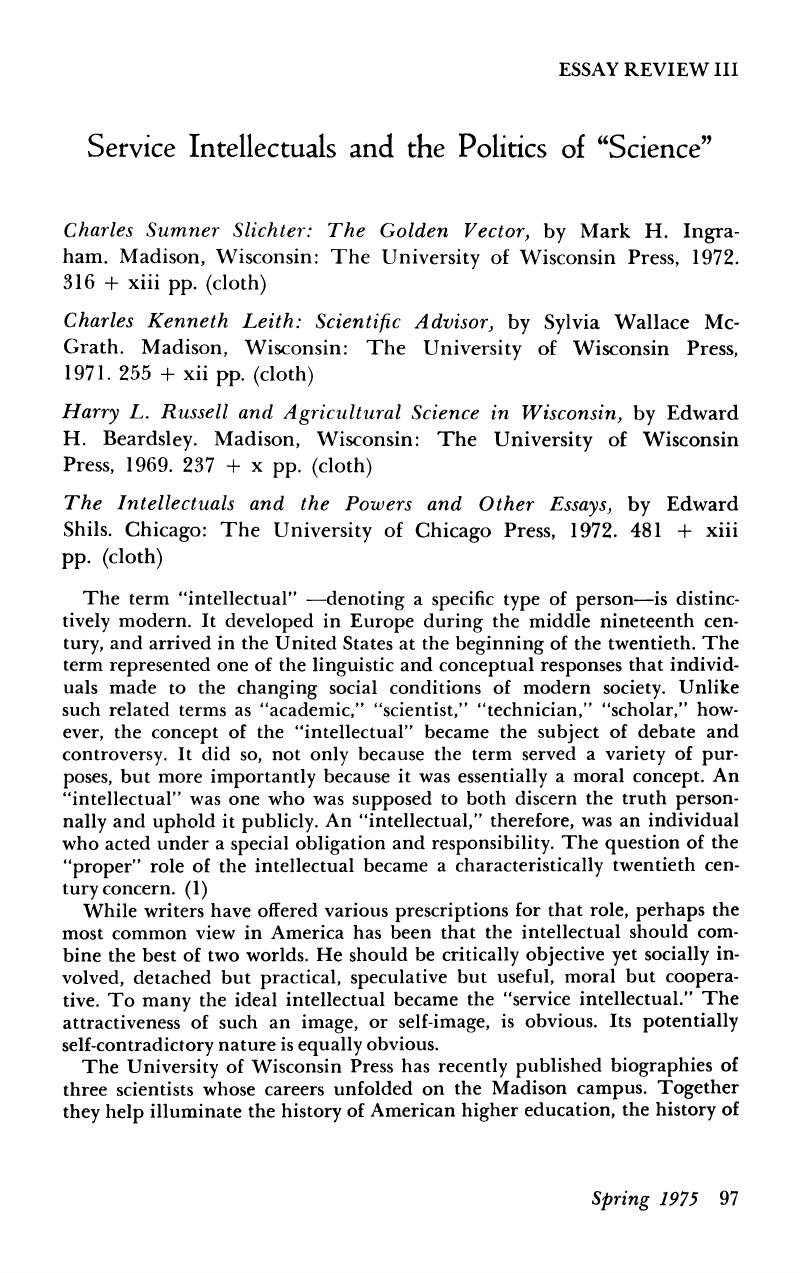No CrossRef data available.
Article contents
Service Intellectuals and the Politics of “Science”
Published online by Cambridge University Press: 24 February 2017
Abstract

- Type
- Essay Review III
- Information
- Copyright
- Copyright © 1975 by New York University
References
Notes
1. For treatments of the term “intellectual” as well as of the activities of such individuals see: Hofstadter, Richard, Anti-Intellectualism in American Life (New York, 1962); Veysey, Laurence R., The Emergence of the American University (Chicago, 1965); Williams, Raymond, Culture and Society, 1780–1950 (New York, 1958); Lasch, Christopher, The New Radicalism in America, 1889–1963: The Intellectual as a Social Type (New York, 1965); Coser, Lewis A., Men of Ideas: A Sociologist's View (New York, 1965); Philip Rieff, ed., On Intellectuals: Theoretical Studies / Case Studies (Garden City, N. Y., 1970).Google Scholar
2. Charles Sumner Slichter apparently claimed that he wanted to have $50,000 by the time he was fifty years old. By 1914, when he was fifty, he had succeeded. Charles Kenneth Leith left an estate of almost $1,700,000 at his death. By 1928, Harry L. Russell's yearly income was over $50,000.Google Scholar
3. Ingraham, Mark H., Charles Sumner Slichter: The Golden Vector (Madison, Wisconsin, 1972, pp. 3–4.Google Scholar
4. Ibid., 176.Google Scholar
5. McGrath, Sylvia Wallace, Charles Kenneth Leith: Scientific Advisor (Madison, Wisconsin, 1971), p. 224.Google Scholar
6. Ibid., p. 65.Google Scholar
7. Ibid., p. 229.Google Scholar
8. Ibid., p. 165.Google Scholar
9. Ibid., p. 172.Google Scholar
10. Ibid., p. 106.Google Scholar
11. Ibid., p. xi.Google Scholar
12. Beardsley, Edward H., Harry L. Russell and Agricultural Science in Wisconsin (Madison, Wisconsin, 1969), p. 119.Google Scholar
13. Ibid., p. 115.Google Scholar
14. See, for example, Kuhn, Thomas S., The Structure of Scientific Revolutions, 2nd ed. (Chicago, 1970); Friedrichs, Robert W., A Sociology of Sociology (New York, 1970); Roszak, Theodore, The Making of a Counter Culture: Reflections on the Technocratic Society and Its Youthful Opposition (Garden City, N. Y., 1969); Chomsky, Noam, Problems of Knowledge and Freedom (New York, 1971); Chomsky, Noam, Language and Mind, enlarged ed. (New York, 1972); Gouldner, Alvin W., The Coming Crisis of Western Sociology (New York, 1970); Michael Polanyi Personal Knowledge: Toward a Post-Critical Philosophy (Chicago, 1958); Wright Mills, C., The Sociological Imagination (New York, 1959); Lynd, Robert S., Knowledge for What? The Place of Social Science in American Culture (Princeton, New Jersey, 1939); Hudson, Liam, The Cult of the Fact: A Psychologist's Autobiographical Critique of His Discipline (New York, 1972); Marcuse, Herbert, One-Dimensional Man: Studies in the Ideology of Advanced Industrial Society (Boston, 1964); and Obler, Paul C. and Estrin, Herman A., eds., The New Scientist: Essays on the Methods and Values of Modern Science (Garden City, N. Y., 1962).Google Scholar
15. Shils, Edward, The Intellectuals and the Powers and Other Essays (Chicago, 1972), pp. vii, x.Google Scholar
16. Ibid., p. 116.Google Scholar
17. Ibid., p. 195, xii.Google Scholar
18. Ibid., p. 47 Google Scholar
19. Ibid., p. 176.Google Scholar
20. Ibid., p. 154.Google Scholar
21. Ibid., p. 192.Google Scholar
22. Labedz, Leopold, “The Structure of the Soviet Intelligentsia.” Daedalus, 89 (Summer, 1960), 504; Malia, Martin, “What is the Intelligentsia?” Ibid., 443.Google Scholar
23. Shils, , 27.Google Scholar
24. Ibid., 29.Google Scholar
25. Purcell, Edward A. Jr., The Crisis of Democratic Theory: Scientific Naturalism and the Problem of Value (Lexington, Kentucky, 1973).Google Scholar
26. Ideology, in Shils sense, is perhaps most relevant in dealing with communism and Stalinism. Even here, however, it tends to simplify complex historical phenomena. See, for example, such diverse perspectives as Deutschler, Isaac, Stalin: A Political Biography (London, 1949); Djilas, Milovan, The Unperfect Society: Beyond the New Class (New York, 1969); and Von Laue, Theodore H., Why Lenin? Why Stalin? (Philadelphia, 1971; Gardner, Lloyd, Schlessinger, Arthur Jr., and Morgenthau, Hans, The Origins of the Cold War (Waltham, Mass., 1970), pp. 79–102. Recent work on Nazism emphasizes the significance of complex social and economic roots: see especially, Hildebrand, Klaus, “Hitlers ort in Der Geschichte Des Preussisch-Deutschen Nationalstaates,” Historische Zeitschrift (December, 1973), 584–632; and “The Coming of the Nazis,” Times Literary Supplement, (February 1, 1974), 93–96. Contrary to Shils implications, most American intellectuals kept a considerable distance between themselves and the Communist Party: Alexander, Charles C., Nationalism in American Thought, 1930–1945 (Chicago, 1969); Aaron, Daniel, Writers on the Left: Episodes in American Literary Communism (New York, 1961); and Warren, Frank, Liberals and Communism (Bloomington, Indiana, 1966). Pells', Richard H. thoughtful and comprehensive Radical Visions and American Dreams: Culture and Social Thought in the Depression Years (New York, 1973) clearly shows the inadequacy of “ideological attitudes” as an explanation for the beliefs and behavior of intellectuals in the thirties. For both a broad treatment of the structural causes of political change, and an appraisal of the harshness of “liberal” societies, see Moore, Barrington Jr., Social Origins of Dictatorship and Democracy: Lord and Peasant in thte Making of the Modern World (Boston, 1966).Google Scholar
27. Shils, , The Intellectuals and the Powers and Other Essays, p. 39.Google Scholar
28. Ibid., p. 38.Google Scholar


